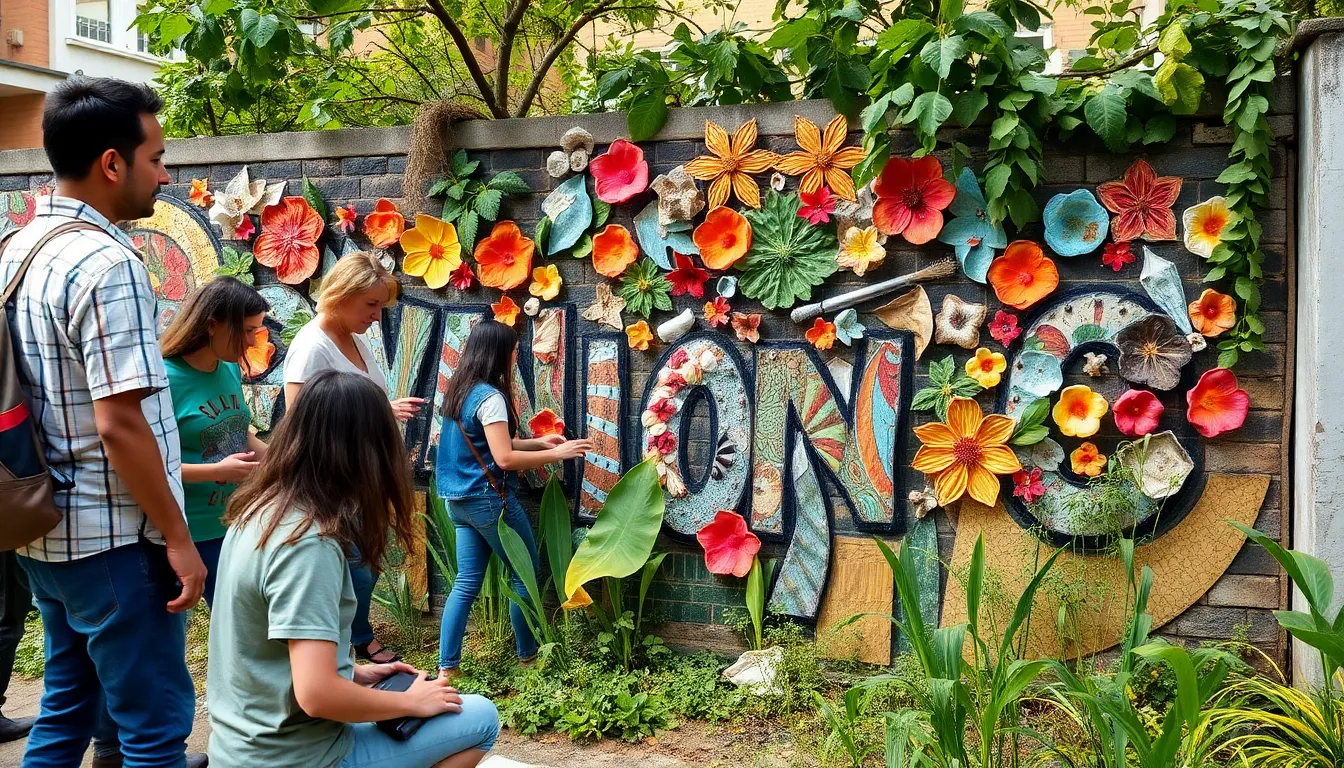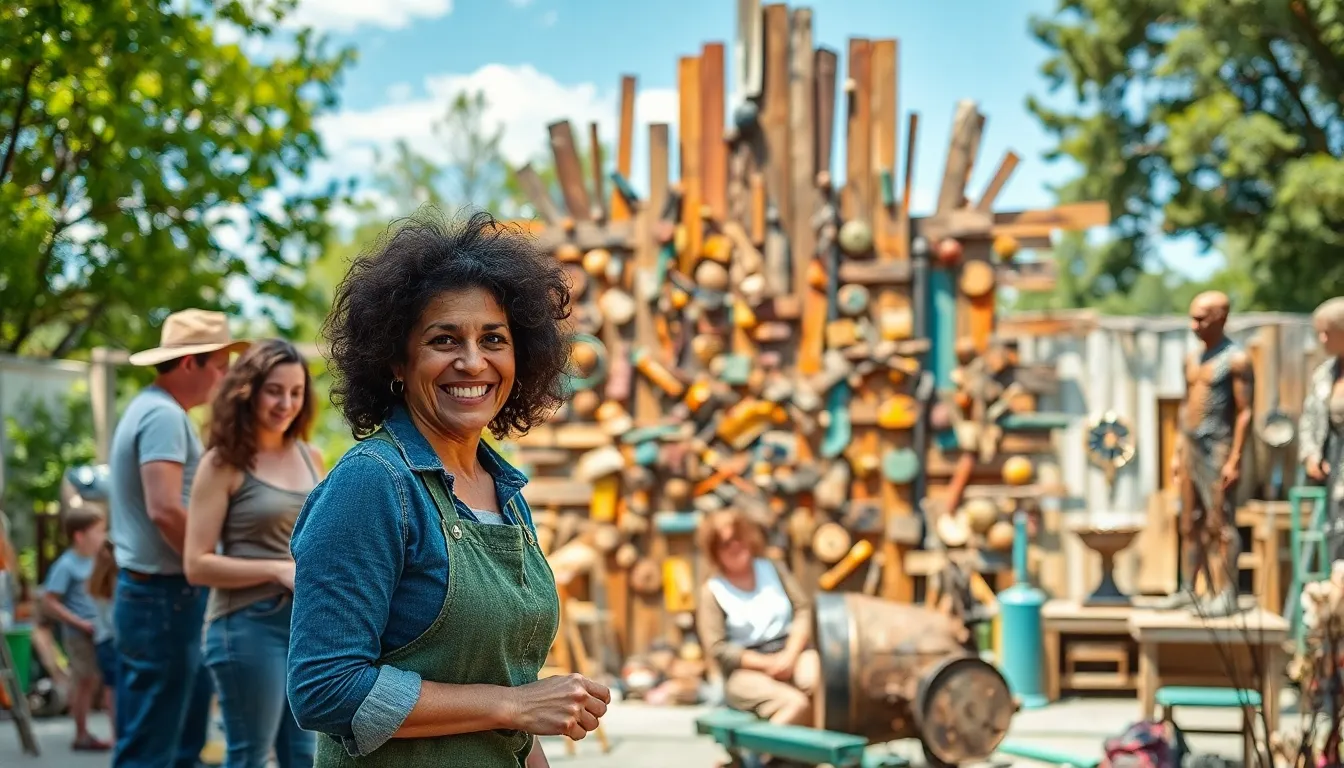Imagine a world where art doesn’t just hang on walls but also saves the planet. That’s the magic of sustainable art. It’s not just about pretty pictures; it’s a movement that combines creativity with eco-consciousness. Artists are swapping traditional materials for recycled treasures, transforming what was once trash into stunning masterpieces. Who knew that saving the Earth could look so good?
Table of Contents
ToggleOverview of Sustainable Art
Sustainable art represents a fusion of creativity and environmental ethics. Artists actively use recycled materials, bringing new life to what would otherwise become waste. Many creators explore eco-friendly practices, ensuring their processes have minimal impact on the planet.
Innovative approaches often incorporate found objects, waste products, and even natural resources. These materials can transform conventional artistry into something profound, showcasing the beauty within discarded items. Community engagement plays a vital role, with artists collaborating on projects that raise awareness about sustainability.
Several techniques, such as upcycling and biomimicry, exemplify sustainable art’s dynamic nature. Upcycling involves turning old items into art pieces, enhancing their value and message. Biomimicry draws inspiration from nature, leading to artworks that reflect ecological principles.
Art installations and public pieces frequently address environmental issues, engaging audiences emotionally. These works challenge viewers to rethink their relationship with consumption and waste. Additionally, exhibitions focused on sustainable art often promote dialogues about ecological responsibility.
Many educational programs highlight sustainable art practices, encouraging future generations of artists to prioritize environmental consciousness. Schools and universities incorporate sustainability into their curricula, fostering a culture of creativity that respects the Earth. Artists’ communities worldwide increasingly emphasize the importance of eco-friendly practices, contributing to a global movement.
Significantly, sustainable art redefines traditional boundaries, advocating for a balance between artistry and ecological awareness. Its emergence continues to inspire others to create responsibly while making impactful statements about the environment. As art evolves, so does the responsibility artists embrace toward the planet.
Key Principles of Sustainable Art

Sustainable art encompasses essential principles that guide its creation and impact. Two of the most significant are environmental awareness and social responsibility.
Environmental Awareness
Emphasizing environmental awareness proves crucial for sustainable art. Artists often choose to incorporate recycled materials into their works, directly influencing waste reduction. Artistic expressions frequently highlight pressing concerns like climate change, pollution, and resource depletion. By using found objects, creators open a dialogue regarding sustainability and its importance. Projects that utilize natural resources promote a connection to the environment and inspire viewers to reflect on their consumption habits. Engaging communities through educational exhibits fosters a deeper understanding of ecological issues, pushing for environmentally responsible practices in art.
Social Responsibility
Social responsibility represents another vital aspect of sustainable art. Artists frequently advocate for social justice, using their platforms to raise awareness about various issues. Collaborations among creators serve to amplify voices and address community needs. By creating art that engages the public, they challenge norms and encourage dialogue about inequality and environmental degradation. Educational outreach helps empower community members, fostering a sense of collective responsibility. As artists prioritize sustainable methods and materials, they contribute not only to ecological health but also to societal betterment through their art.
Materials and Techniques in Sustainable Art
Sustainable art relies on eco-friendly materials and innovative techniques that align with environmental principles. Artists prioritize sustainability by selecting resources with minimal ecological footprints.
Eco-Friendly Materials
Recycled paper, reclaimed wood, and upcycled fabrics emerge as popular choices among artists. Each material offers a unique aesthetic while promoting waste reduction. Biodegradable materials like clay and natural pigments also find their place in sustainable art. These options minimize harmful environmental impacts unlike conventional supplies. Local sourcing further reinforces the commitment to sustainability since it reduces transportation emissions. Sustainability remains at the forefront as artists transform everyday items into beautiful expressions of art.
Innovative Techniques
Upcycling stands out as a transformative technique, allowing artists to repurpose discarded objects into new creations. Techniques such as installing and assembling found materials add dimension and narrative to art pieces. Biomimicry, inspired by nature’s designs and processes, influences artistic practices by integrating ecological principles. Collaboration between artists and communities fosters creative problem-solving, enhancing sustainability within projects. Interactive installations often engage audiences, sparking conversations about ecological awareness. Each technique reinforces the message of responsibility toward the planet, creating impactful art that resonates with viewers.
Impact of Sustainable Art on Society
Sustainable art significantly influences society through its emphasis on eco-conscious practices. It fosters community engagement and safeguards cultural heritage, promoting a more responsible and inclusive approach to creativity.
Community Engagement
Artists often collaborate with local residents to create artwork that reflects shared values and environmental concerns. Engaging the community in sustainable art projects generates awareness about environmental issues, leading to collective action. These collaborations frequently involve workshops and public installations that draw attention to local resources and challenges. Participants gain a deeper understanding of sustainability while contributing to the artistic process. Each project serves as a catalyst for discussions around consumption and waste, fostering a sense of unity among participants. Through these efforts, sustainable art encourages a proactive community mindset toward ecological stewardship.
Cultural Preservation
Sustainable art plays a vital role in preserving cultural heritage and celebrating diverse practices. It highlights traditional techniques and materials, ensuring they’re not forgotten in a rapidly modernizing world. Artists often incorporate local crafts and narratives, weaving them into contemporary works that resonate with current audiences. By utilizing indigenous materials, these artists honor and revive cultural identities, creating a bridge between past and present. Projects rooted in cultural preservation invite communities to engage with their history, enhancing collective identity. Each piece of sustainable art contributes to a broader understanding of cultural sustainability, reinforcing the importance of maintaining traditions amidst environmental changes.
Future of Sustainable Art
Sustainable art continues to evolve, embracing innovative techniques and materials that align with environmental and social goals. Artists increasingly explore digital technologies to create virtual installations, reducing physical resource consumption. Future projects often emphasize local resources and handmade processes, fostering community engagement while minimizing ecological footprints.
Trends indicate a shift toward art that actively addresses climate change, prompting conversations about urgent global issues. Artists collaborate with scientists to visualize data and create impactful installations, turning abstract concepts into tangible experiences. Workshops and community-driven initiatives encourage collective creativity, strengthening bonds among participants.
The emergence of biophilic design in sustainable art enhances connections with nature, reflecting humanity’s innate attraction to natural elements. Such designs challenge artists to incorporate living materials and integrate them into everyday spaces, promoting environmental well-being. As the movement grows, initiatives aim to motivate individuals toward sustainable living practices through their interactions with art.
Art fairs and galleries increasingly prioritize sustainability, showcasing eco-friendly works that resonate with audiences. Curators look for innovative pieces that provoke thought and inspire action, ensuring that sustainable art gains wider visibility. Social media platforms amplify these messages, reaching diverse demographics and promoting awareness of environmental issues.
Furthermore, educational institutions play a significant role in shaping the future of sustainable art. Curricula adapt to include sustainability principles, equipping emerging artists with the knowledge and skills to address environmental challenges. Collaborations between artists and educational organizations nurture a new generation committed to eco-conscious creation.
As the future unfolds, sustainable art becomes a vital tool for decision-makers, guiding cultural policies and promoting positive environmental actions. By reinforcing a narrative around art and sustainability, society witnesses the potential for significant change while valuing creativity as a force for good. This shift underscores the importance of commitment to the planet, as the boundaries between art and ecological stewardship continue to blur.
Sustainable art stands at the intersection of creativity and environmental responsibility. It empowers artists to transform waste into meaningful expressions while fostering community engagement. As this movement evolves, it not only raises awareness about pressing ecological issues but also inspires collective action.
The innovative techniques and materials used in sustainable art reflect a commitment to preserving cultural heritage while addressing modern challenges. By embracing eco-friendly practices, artists pave the way for a future where art serves as a catalyst for change. With each piece, they challenge societal norms and encourage a deeper connection to the environment, making sustainable art a vital force for good.


